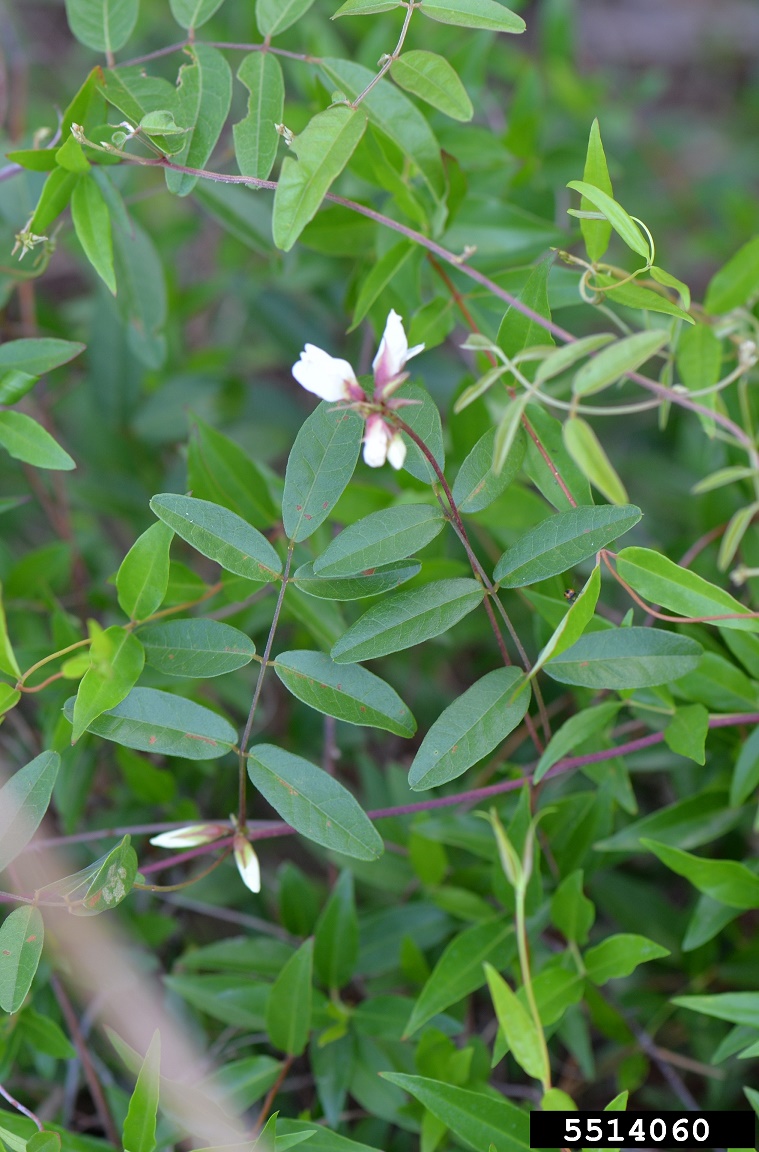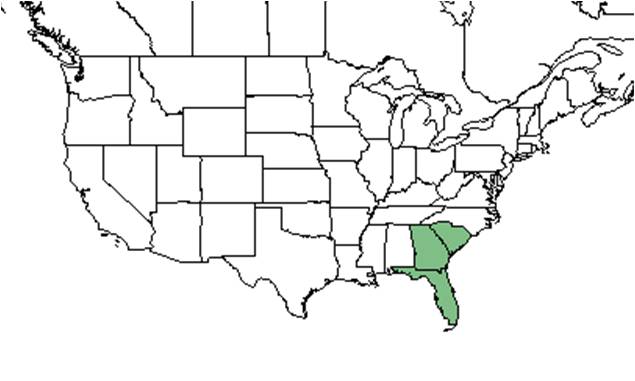Galactia elliottii
| Galactia elliottii | |
|---|---|

| |
| Photo by Karan A. Rawlins, University of Georgia, Bugwood.org | |
| Scientific classification | |
| Kingdom: | Plantae |
| Division: | Magnoliophyta - Flowering plants |
| Class: | Magnoliopsida - Dicotyledons |
| Order: | Fabales |
| Family: | Fabaceae ⁄ Leguminosae |
| Genus: | Galactia |
| Species: | G. elliottii |
| Binomial name | |
| Galactia elliottii Nutt. | |

| |
| Natural range of Galactia elliottii from USDA NRCS Plants Database. | |
Common name: Elliott's milkpea
Contents
Taxonomic notes
Synonyms: none.[1]
Varieties: none.[1]
Description
Galactia elliottii is a perennial, viney, herbacious legume. Leaves are alternate and petiolate with inconspicuous, green stipules.[2] It is a nitrogen fixing plant. [3]
Generally, the genus Galactia are "trailing or twining, climbing, perennial, herbaceous or woody vines or erect, perennial herbs or rarely shrubs. Leaves 1-pinnate, usually 3-foliolate (or rarely 1-,5-7-,9-folilolate); leaflets entire, petiolulate, stipellate. Racemes axillary, pedunculate with few to numerous, papilionaceous flowers borne solitary or 2-several at a node, ech subtended by a bract and fusion of the 2 uppermost, with the laterals usually shorter than the uppermost and lowermost; petals usually red, purple, pink or white; stamens diadelphous or elsewhere occasionally monadelphous; ovary sessile or shortly stipitate. Legume oblong-linear to linear, few-many seeded, compressed, straight or slightly curbed, dehiscent with often laterally twisting valves.[4]
Specifically, for Galactia elliottii they are "twining, climbing herbaceous vine or somewhat woody at base with sparsely to densely, antrorsely, retrorsely or spreading, strigillose to hirsute stems, 0.51-.5 m long. Leaves pinnately 7-9 foliolate; leaflets oblong to elliptic, 2-4 cm long, sparsely appressed short-pubescent to glabrous above and moderately to densely strigillose beneath. Racemes with peduncles and rachises sparsely to densely, retrorsely, strigillose to somewhat spreading hirsute, 5-20 cm long; flowers 1-3 at each node on usually densely and retrorsely short-hirsute pedicels 1-2.5 mm long. Calyx appressed to somewhat spreading strigillose to short-pilose, tube ca. 3 mm lon, lobes 7-10 mm long; petals white or tinged with red, the standard 1.2-1.5 cm long. Legume 3.5-5 cm long, 5-8 cm long, 5-8 mm broad, densely appressed- tomentose."[4]
The root system of Galactia elliottii includes stem tubers which store non-structural carbohydrates (NSC) important for both resprouting following fire and persisting during long periods of fire exclusion.[5] Diaz-Toribio and Putz (2021) recorded this species to have an NSC concentration of 232.3 mg/g (ranking 18 out of 100 species studied) and water content of 55.8% (ranking 43 out of 100 species studied).[5]
Distribution
Galactia elliottii is endemic to an area from southern South Carolina to peninsular Florida, but the majority is found in Florida.[6]
Ecology
Habitat
In the Coastal Plain in Florida, G. elliottii can be found in pine flatwoods, sandy scrub, dry pine woods, and mesic transition zones between scrubs and seepage forests. In disturbed areas it has been found in railroad gravel and in coarse sandy roadsides amongst grasses. [7] It is often found in Spodosol soils. [8] Associated species include Croton glandulosus, Paspalum notatum, and Sporobolus virginicus. [7]
Many legume species are light sensitive, yield decreases as shade increases. However, G. elliottii possesses and adaptation to shade by producing more herbage and seed under partial shade than full sunlight. [9]
G. elliottii is a nitrogen fixing legume and requires relatively high concentrations of other nutrients such as phosphorus and iron. [10] Phosphorus has been found to enhance yield of herbage and roots. [9]
Galactia elliottii is an indicator species for the Xeric Flathills community type as described in Carr et al. (2010).[11]
Phenology
The white flowers have diadelphous stamens, and can be observed blooming May, June, August, and September.[12][7][13]
G. elliottii naturally senescences during autumn months, this is a grazing management strategy to defer autumn grazing allowing depleted plants to restore vigour. [14] It has been found to not be tolerant of repeated defoliation because this species persists primarily through survival of individual plants and vegetative propagation.
Fire ecology
In fire suppressed scrubby flatwoods, it can become overgrown and be a dominant understory species. [15] Schmalzer and Hinkle[16] found that G. elliottii has a seasonal response to fire, present in June (6 and 18 months postburn) and not in winter.
Pollination
Galactia elliottii has been observed at the Archbold Biological Station to host sweat bees from the family Halictidae such as Halictus poeyi and Nomia maneei and leafcutting bees from the family Megachilidae such as Anthidiellum notatum rufomaculatum, Megachile exilis parexilis, M. georgica, M. mendica and M. petulans[17]
Conservation, cultivation, and restoration
Cultural use
Photo Gallery
References and notes
- ↑ 1.0 1.1 Weakley, A.S. 2015. Flora of the southern and mid-atlantic states. Working Draft of 21 May 2015. University of North Carolina at Chapel Hill, Chapel Hill, North Carolina.
- ↑ [Encyclopedia of Life]Accessed December 11, 2015
- ↑ Stiling, Peter et al.. “Elevated CO₂ Lowers Relative and Absolute Herbivore Density Across All Species of a Scrub-oak Forest”. Oecologia 134.1 (2003): 82–87.
- ↑ 4.0 4.1 Radford, Albert E., Harry E. Ahles, and C. Ritchie Bell. Manual of the Vascular Flora of the Carolinas. 1964, 1968. The University of North Carolina Press. 643-4. Print.
- ↑ 5.0 5.1 Diaz-Toribio, M.H. and F. E. Putz 2021. Underground carbohydrate stores and storage organs in fire-maintained longleaf pine savannas in Florida, USA. American Journal of Botany 108: 432-442.
- ↑ Sorrie, B. A. and A. S. Weakley 2001. Coastal Plain valcular plant endemics: Phytogeographic patterns. Castanea 66: 50-82.
- ↑ 7.0 7.1 7.2 Florida State University Robert K. Godfrey Herbarium database. URL: http://herbarium.bio.fsu.edu. Last accessed: October 2015. Collectors: Loran C. Anderson, Edwin L. Bridges, R.K. Godfrey, Ed Keppner, Lisa Keppner, Robert A. Norris, Steve L. Orzell. States and Counties: Florida: Bay, Highlands, Nassau, Polk, St. Johns, Taylor, Volusia. Compiled by Tall Timbers Research Station and Land Conservancy.
- ↑ Cite error: Invalid
<ref>tag; no text was provided for refs namedMuir and Pitman 1987 - ↑ 9.0 9.1 Muir, J. P. and W. D. Pitman (1989). "Response of the Florida legume Galactia elliottii to shade." Agroforestry Systems 9(3): 233-239.
- ↑ J. A. Langley, B. G. Drake, and B. A. Hungate. “Extensive Belowground Carbon Storage Supports Roots and Mycorrhizae in Regenerating Scrub Oaks”. Oecologia 131.4 (2002): 542–548. Web...
- ↑ Carr, S.C., K.M. Robertson, and R.K. Peet. 2010. A vegetation classification of fire-dependent pinelands of Florida. Castanea 75:153-189.
- ↑ Nelson, G. PanFlora: Plant data for the eastern United States with emphasis on the Southeastern Coastal Plains, Florida, and the Florida Panhandle. www.gilnelson.com/PanFlora/ Accessed: 9 DEC 2016
- ↑ [Lady Bird Johnson Wildflower Center]Accessed: December 11, 2015
- ↑ Muir, J.P. and W.D. Pitman (1991). "RESPONSES OF DESMANTHUS-VIRGATUS, DESMODIUM-HETEROCARPON, AND GALACTIA-ELLIOTTII TO DEFOLIATION". Journal of Tropical Grasslands 25(3):291-296.
- ↑ Silva-Lugo, Jose L., and George W. Tanner. “Testing Control Sites for Fire Ecology Research”.Journal of the Torrey Botanical Society 137.2/3 (2010): 263–276.
- ↑ Schmalzer, Paul A., and C. Ross Hinkle. “Recovery of Oak-saw Palmetto Scrub After Fire”.Castanea 57.3 (1992): 158–173.
- ↑ Deyrup, M.A. and N.D. 2015. Database of observations of Hymenoptera visitations to flowers of plants on Archbold Biological Station, Florida, USA.